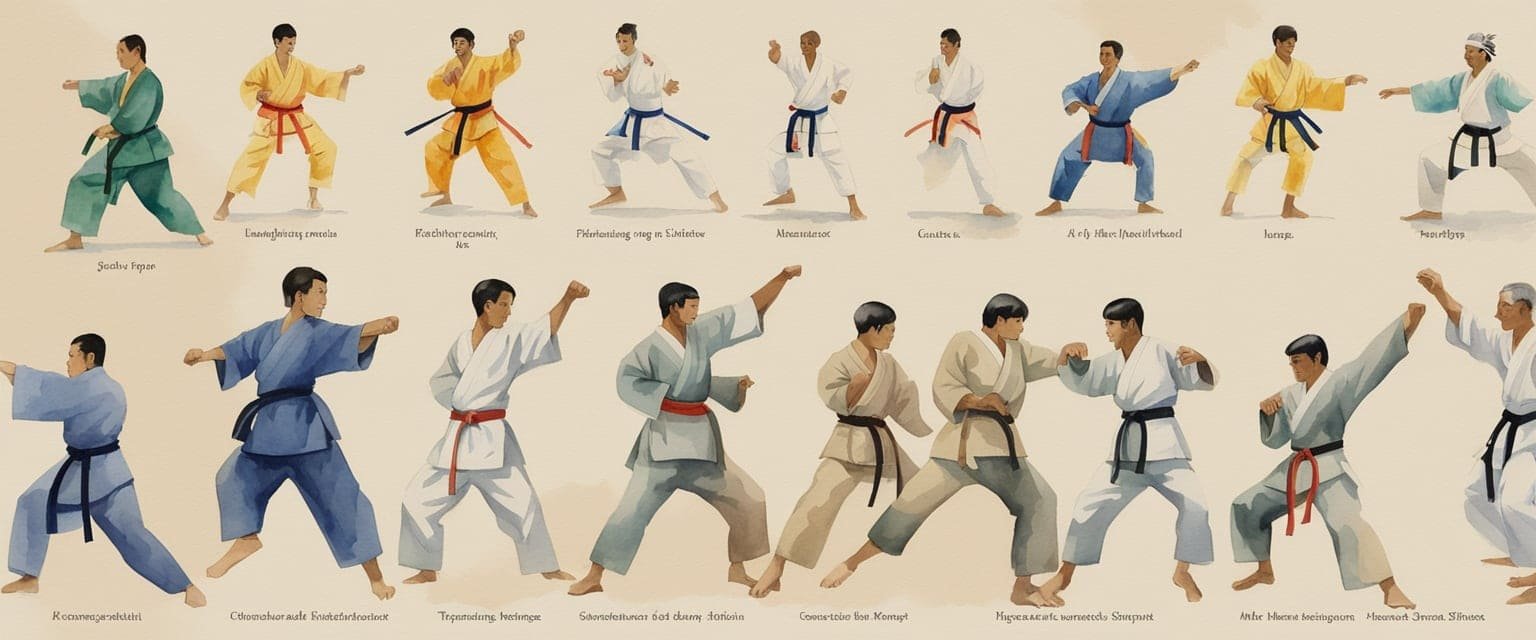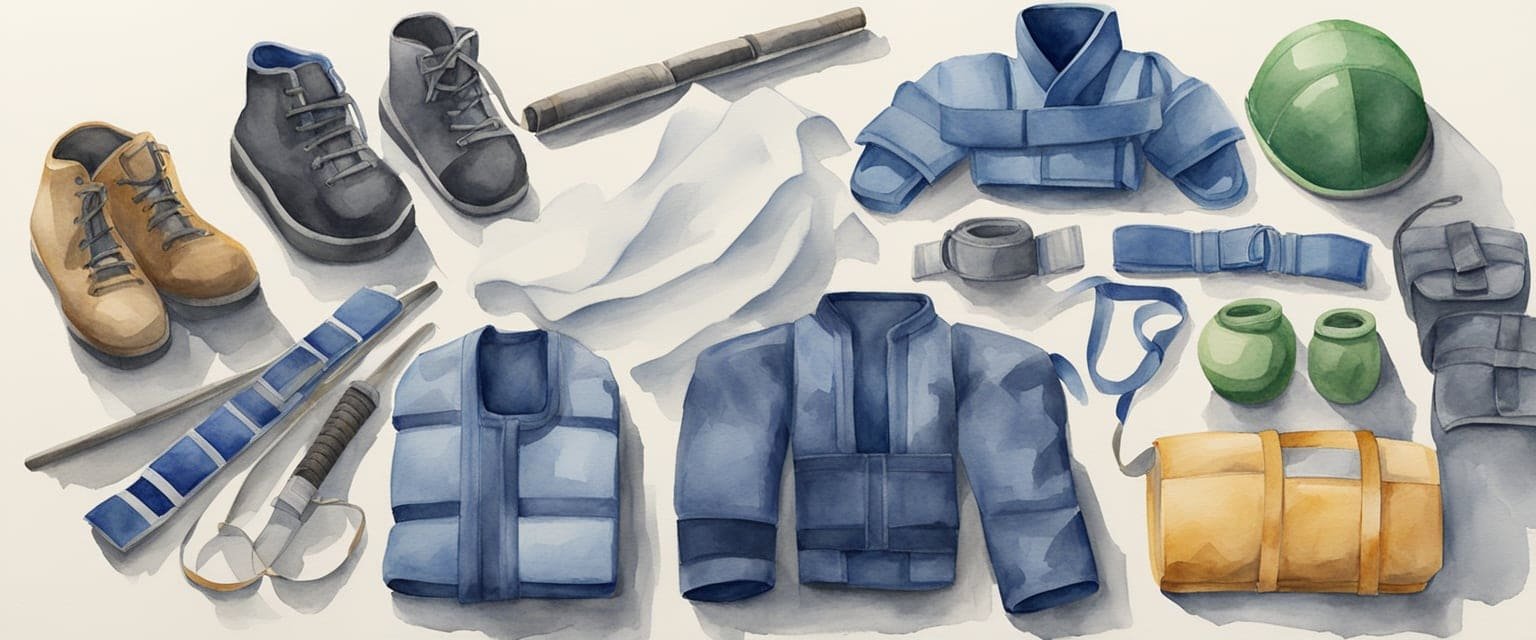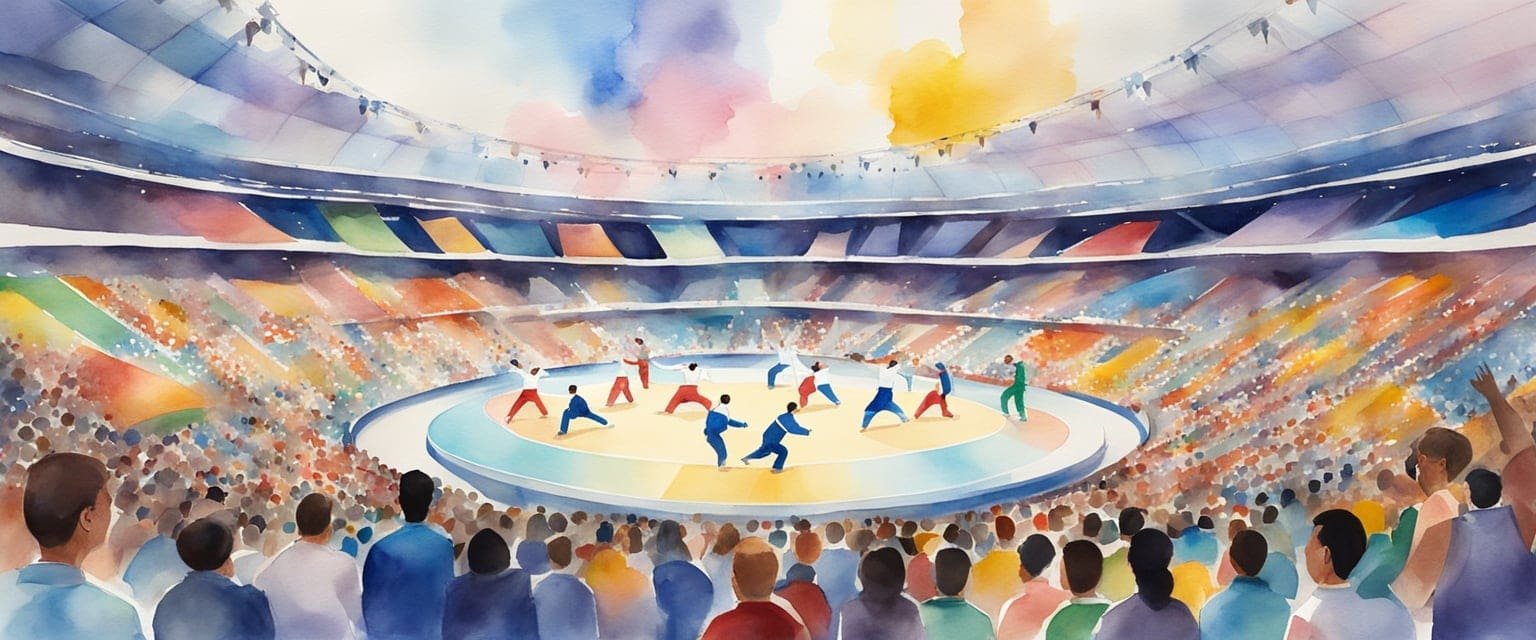Olympic Karate is a thrilling sport that combines skill, discipline, and tradition. In this ultimate guide, I will break down everything you need to know about Olympic Karate, from its rich history to the techniques that make it a unique martial art. Whether you’re a fan of the sport, a budding karateka, or just curious about what goes on in the dojo, this article will provide you with valuable insights.

I’ll explore the differences between kata and kumite, the scoring system in competitions, and the gear that athletes use. Understanding these elements will enhance your appreciation of the sport and might even inspire you to join a class. Join me as I dive into the exciting world of Olympic Karate!
Key Takeaways
- Olympic Karate includes two main categories: kata and kumite.
- Athletes compete for medals in various weight divisions and skill levels.
- Proper training and technique are essential for success in competitions.
History and Evolution of Olympic Karate

Karate has a rich history that traces back to Okinawa and has evolved significantly over the years. The journey from a local martial art to an Olympic event is fascinating and shows how karate has gained global recognition.
Origins of Karate in Okinawa
Karate originated on Okinawa, a small island in Japan. It developed from indigenous fighting styles combined with influences from Chinese martial arts. The term “karate” means “empty hand,” reflecting its focus on unarmed techniques.
In the early 20th century, figures like Gichin Funakoshi played a crucial role in popularizing karate outside Okinawa. Funakoshi introduced it to mainland Japan, leading to the formation of various styles, including Shotokan, Goju-ryu, and Shito-ryu.
These developments established karate as a recognized Japanese martial art. The emphasis on physical fitness, mental discipline, and self-defense attracted practitioners worldwide.
Karate Becoming an Olympic Sport
The journey to Olympic recognition began in the 1970s when the International Olympic Committee (IOC) started to explore including karate. Efforts intensified under the auspices of the World Karate Federation (WKF), which standardized rules and competitions.
In 2009, karate faced a setback when it failed to secure enough votes for the 2016 Olympics. Still, the sport persisted, showcasing its popularity and depth. After years of advocacy and growing global support, karate was finally included in the Olympic program for the Tokyo 2020 Games.
This inclusion marked a significant milestone, highlighting karate’s appeal and the dedication of its practitioners.
Karate at Tokyo 2020 Olympics
At the Tokyo 2020 Olympics, karate made its debut at the iconic Nippon Budokan, the birthplace of modern karate in Japan. The event featured two main disciplines: kumite (sparring) and kata (forms).
I remember the excitement as athletes from around the world showcased their skills and passion. Competitors aimed for both medals and the honor of representing their countries.
The event was a celebration of karate’s rich heritage and a testament to its growth as a global sport. Looking ahead, the anticipation for karate at the Paris 2024 Olympics continues to build.
Understanding Karate as a Martial Art
Karate is more than just a way to defend oneself; it is a rich and meaningful discipline. To me, the philosophy behind karate and the life of a karateka provide deep insights into this Japanese martial art.
The Philosophy and Discipline of Karate
Karate emphasizes both physical and mental strength. The philosophy centers around personal growth and self-discipline. Each training session at the dojo teaches me respect, focus, and perseverance.
Practicing karate involves forming strong habits. The repetitive nature of techniques fosters muscle memory. This discipline shapes my character both on and off the mat.
Learning kata, or forms, is essential in karate. These movements are not just for show; they embody principles of balance and control. Through kata, I can internalize the concepts and apply them during sparring or self-defense situations.
Karateka: The Life of a Karate Athlete
Being a karateka involves dedication and hard work. My training schedule typically includes several hours in the dojo each week. Alongside practicing techniques, I focus on improving my physical fitness.
Karate also teaches valuable life skills. It builds confidence and helps me navigate challenges outside the dojo. The lessons learned in karate are applicable in daily life, encouraging resilience and respect for others.
I find that connecting with fellow karateka strengthens our community. We support each other through tough training sessions and share our progress. This camaraderie makes the journey in karate not just personal but also a shared experience.
Karate Techniques and Fundamentals
In my journey through karate, I’ve found that mastering techniques and understanding fundamentals is essential. This section highlights key aspects, including basic stances, various strikes, and how to effectively defend oneself.
Basic Stances, Punches, and Kicks
The foundation of karate lies in its stances. These positions provide stability and readiness. Common stances include zenkutsu-dachi (forward stance) and kokutsu-dachi (backward stance).
In addition to stances, mastering basic punches, like the oi-zuki (lunge punch) and gyaku-zuki (reverse punch), is crucial. For kicks, the mae-geri (front kick) and yoko-geri (side kick) are fundamental. Each punch and kick needs precision and power. Practicing forms, or kata, helps in perfecting these movements.
Advanced Techniques and Combinations
Once I’ve grasped the basics, I can move on to advanced techniques. Combinations are vital for effective sparring. A common combo might involve a jab followed by a cross, then ending with a front kick.
Striking with elbows and knees can be game-changers in close quarters. Techniques like uraken (back fist) or shuto (knife hand) add variety and surprise in attacks. Experimenting with combinations during practice enhances my speed, timing, and adaptability.
Blocks, Grappling, and Self-Defense Moves
Defense is as important as offense in karate. Learning blocking techniques, such as age-uke (rising block) and gedan-barai (downward block), can protect against strikes.
Grappling techniques are also crucial. Moves like throws and joint locks can immobilize an opponent. In self-defense, using basic strikes to create distance is key. I’ve learned to respond effectively to threats while maintaining composure. Balancing these moves prepares me for varied scenarios, whether in competition or real-life situations.
Kata and Kumite: The Core Categories of Competition
In Olympic karate, two main categories define the competition: kata and kumite. Each has its unique style and focus, showcasing different skills and techniques. Understanding these categories is essential for appreciating the sport.
Exploring the Beauty and Precision of Kata
Kata is a series of pre-arranged movements that demonstrate the mastery of karate techniques. Each kata consists of specific forms, known as waza, which are executed with precision and control.
Key Elements of Kata:
- Focus on Technique: The emphasis is on the correctness and fluidity of movements.
- Judging Criteria: Competitors are evaluated based on speed, strength, and clarity of execution.
- Scoring: Points can be awarded for superior performance, with judges looking for techniques that show skill and artistry.
Practicing kata helps athletes improve their body mechanics and mental discipline. It’s fascinating to see how these movements reflect the rich tradition of karate, embodying both beauty and effectiveness.
The Fast-Paced Action of Kumite
Kumite is the sparring aspect of karate, where participants compete against each other in real-time. This dynamic form focuses on the application of techniques learned in kata.
Key Components of Kumite:
- Types of Points: Scoring involves techniques that lead to successful strikes.
- Ippon: A full point awarded for decisive techniques.
- Waza-ari: A half-point for less direct hits.
- Yuko: Points for lighter contact that still score.
- Controlled Combat: Competitors wear protective gear and aim for specific targets like the body and head.
Kumite matches are thrilling, showcasing quick reflexes and strategic thinking. The intensity and competitiveness make it a highlight of any karate event.
Competition Rules and Scoring in Olympic Karate
In Olympic Karate, understanding the competition rules and the scoring system is vital for both athletes and fans. This section explores how points are awarded, what constitutes a foul, and the roles of judges and referees in ensuring fair play.
The Point System and Awarding Ippon
The point system in Olympic Karate is designed to reward effective techniques. Points can be scored as follows:
- Ippon: This is the highest score, given for a decisive technique. It can come from a clean strike that shows control and power.
- Yuko: This score is given for techniques that make solid contact but are less decisive than an Ippon.
Matches last for three minutes, and the competitor with the most points wins. If there’s a tie, a sudden-death round may occur, where the first to score wins. This system emphasizes skill and strategy.
Penalties, Fouls, and Target Areas
Penalties can affect the course of a match. Fouls typically include actions that are dangerous or against the spirit of the sport. Common fouls are:
- Illegal strikes to the head or back of the opponent.
- Grabbing or holding the opponent.
- Unsportsmanlike conduct.
Target areas for scoring points include the torso and head. I must be careful to strike only in these zones to earn points. This not only keeps the competition fair but also focuses on technique and precision.
Role of Judges and Referees
Judges and referees play crucial roles in Olympic Karate competitions. A panel of judges typically scores the bout, looking for accurate and controlled techniques.
Referees ensure the rules are followed and manage the match flow. They can issue warnings or penalties for fouls and can declare a point or Ippon based on the quality of the technique. Their decisions can greatly influence the match’s outcome, so I appreciate their responsibility in maintaining fairness and integrity in the sport.
Together, judges and referees keep the competition exciting and fair for all.
Athletes and Divisions

In Olympic karate, athletes compete across various weight classes and categories. Understanding these divisions helps appreciate the competition’s depth and the talents of top karatekas.
Weight Classes and Gender Categories
Karate has separate divisions for men and women, each with specific weight classes. This ensures fair competition. In Kumite, there are three men’s categories: under 67 kg, under 75 kg, and over 75 kg. For women, the categories include under 55 kg, under 61 kg, and over 61 kg.
Each weight class features 10 athletes vying for Olympic spots, creating an intense and competitive atmosphere. The structure allows athletes like Steven Da Costa, the men’s under 67 kg champion, and Jovana Preković, the women’s under 61 kg champion, to showcase their skills against similarly matched opponents.
Profiles of Top Karatekas
Among the top karatekas, I find athletes like Steven Da Costa and Jovana Preković truly inspiring. Steven has a strong record, demonstrating exceptional technique and speed in his matches.
Jovana, on the other hand, is known for her focus and powerful strikes. Both athletes represent Japan’s highly skilled karate community. Their journeys highlight the dedication and hard work needed to excel in their weight classes. Watching them compete illustrates the intensity and excitement of Olympic karate.
Karate Gear and Equipment

Having the right gear is essential for practicing karate effectively and safely. The karate gi and protective equipment play vital roles in my training and competition experiences. Here is what I consider important.
The Karate Gi: Tradition and Significance
The karate gi is the traditional uniform worn by practitioners. It consists of a jacket and pants, usually in white. This color symbolizes purity and the beginner’s journey in karate.
The jacket fits loosely, allowing for freedom of movement, while the pants are also flexible. Often, I find myself tying my belt around my waist to secure the jacket. The belt, known as an obi, represents my rank and progress.
As I train, I appreciate that my gi represents respect for the art and its history. Taking care of my uniform is just as important, as a clean gi reflects my dedication to karate.
Protective Gear and Belts: Blue and Red
Protective gear is vital for safety during training and sparring. I always wear gear like gloves, mouthguards, and headgear. This equipment helps shield me from injuries while allowing me to practice techniques effectively.
In competitions, I notice the use of colored belts of different ranks, like blue and red. The blue belt shows a higher level of skill, while the red belt often signifies an advanced position.
These belt colors remind me of my journey and the hard work I’ve put in to advance. Using protective gear and understanding belt significance keeps me focused on my goals in karate.
Training for Olympic Karate
Training for Olympic karate is all about building both mental focus and physical strength. It’s essential to be committed to technique and develop a routine that enhances athletic performance. Here’s a closer look at how I approach my training.
Developing Mental Focus and Physical Strength
Building mental focus is just as crucial as physical strength in karate. I practice techniques that help me stay calm and concentrate during matches. Visualization is one exercise I use. It involves picturing myself performing movements perfectly. This not only boosts my confidence but also prepares my mind for competition.
Strength training also plays a big role. I focus on exercises like squats, lunges, and push-ups to build overall muscle. These movements improve my power and endurance in the dojo. It’s important for me to balance strength training with karate practice to prevent overworking my muscles.
Typical Training Regimen of a Karateka
A typical training regimen for me includes a mix of drills, sparring, and conditioning. I start with a warm-up session to get my muscles ready. This usually involves stretches and light cardio to raise my heart rate.
Next, I dedicate time to practicing techniques. I repeat kata and kumite drills to sharpen my skills. Sparring with partners is pivotal, as it simulates real competition and helps with timing and distance.
Finally, I include cool-down stretches to aid recovery. I find this routine keeps me strong and focused, allowing me to perform my best when it counts.
Major Competitions and Events

Karate has a rich history of competitions at various levels, showcasing talent worldwide. I find the structure of these events important as they not only help athletes improve but also elevate the sport’s profile.
World Karate Federation Championships
The World Karate Federation (WKF) Championships are some of the most prestigious events in karate. Held every two years, this competition attracts top martial artists from around the globe.
Categories include both Kumite and Kata. Athletes compete in various weight classes in Kumite. This ensures fair play and exciting matches. The WKF Championships also act as a qualifier for other major events, including the Olympics.
I love watching the high level of skill and dedication shown by the participants. They often train for years to showcase their abilities in this event. Many future champions are discovered here.
Qualifying for the Olympics and Ranking Rounds
Qualifying for the Olympics is a crucial journey for many karate athletes. The qualification process involves various events, including ranking rounds that determine who will compete.
Ranking rounds assess athletes based on their performances in competitions, including the WKF Championships. The results of these events help generate points that contribute to an athlete’s world ranking.
For the Tokyo Games, karate was part of the Olympic program for the first time, making these qualifying events even more critical. Competing in the Youth Olympic Games also provides younger athletes a chance to gain experience.
For many, the thrill of striving for an Olympic spot motivates them to train harder and improve constantly.
The Future of Olympic Karate
As we look ahead, Olympic Karate is set to evolve in exciting ways. The legacy of Tokyo 2020 lays a strong foundation for future competitions, especially with Paris 2024 on the horizon. I believe this transition will spotlight emerging talents while reshaping the competition landscape.
Evolution of Karate Post-Tokyo 2020
The debut of Karate in the Tokyo 2020 Olympics marked a significant milestone. I saw how it captivated audiences and introduced the sport to a wider audience.
Since then, the International Olympic Committee (IOC) has been evaluating which sports to include in future Games. Karate’s unique blend of physicality and discipline aligned perfectly with Olympic values. This leads me to think that it can grow even more popular, especially among younger fans. As competitions progress, we can expect changes in rules and formats to enhance viewer engagement. Also, with karate’s exclusion from the 2024 Games, there’s a renewed focus on refining skills and training for athletes.
Emerging Talents and the Road to Paris 2024
As we approach Paris 2024, I am excited to see promising young athletes stepping into the spotlight. Many karatekas are training hard, aiming for gold, silver, and bronze medals. I believe these emerging talents reflect the true spirit of Karate, showcasing determination and skill.
Countries like Japan and France have strong schools and programs nurturing these athletes. I admire how they are adapting their training regimens to include not only sparring but also mental toughness and strategy. This holistic approach can make a real difference in competition, especially in high-pressure situations. From what I see, the future is bright for Olympic Karate as new champions are ready to rise and inspire fans worldwide.
Frequently Asked Questions

In this section, I’ll answer some common questions about Olympic karate. These include the events, qualification process, rules, and the evolution of karate in the Olympics.
What events are included in Olympic karate competitions?
Olympic karate features two main events: kata and kumite. Kata is a set routine demonstrating techniques and forms, while kumite is sparring between athletes.
How does one qualify for Olympic karate?
To qualify for Olympic karate, athletes must compete in designated tournaments and earn points based on their performance. The top-ranked competitors from their regions may secure a spot in the Games.
What are the rules and scoring system in Olympic karate?
The scoring system in Olympic karate is based on the effectiveness of techniques during kumite. Points are awarded for controlled strikes, and judges score each match based on criteria like speed and precision.
Who were the Olympic karate medalists in previous games?
At the Tokyo 2020 Olympics, gold medals were awarded to Jesse Enkamp in men’s kata and to Aina Oda in women’s kumite. These athletes represented distinct karate styles and showcased their skills on a global stage.
What are the differences between Olympic karate and traditional karate styles?
Olympic karate focuses more on competition rules and point scoring, while traditional karate emphasizes self-defense, philosophy, and forms. Traditional styles may include a wider variety of techniques and approaches.
How has Olympic karate evolved since its inclusion in the games?
Since its debut in the 2020 Tokyo Olympics, karate has gained international recognition. The focus on sport has influenced training methods, with more athletes increasing their exposure to global competitions.

